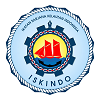PENINGKATAN KUALITAS LINGKUNGAN DI KAWASAN NELAYAN SEPULUH - MADURA
Abstract
Usaha perbaikan lingkungan permukiman kumuh nelayan di Kecamatan Sepuluh Madura merupakan upaya strategis yang diharapkan mampu menangani permasalahan lingkungan permukiman nelayan yang terjadi dan dapat mengantisipasi terjadinya permasalahan yang sama di masa mendatang karena kawasan nelayan di Kec. Sepuluh Madura berpotensi sebagai kawasan permukiman. Dengan kondisi yang demikian dan agar dapat meningkatkan kualitas lingkungan di Kec. Sepuluh Kabupaten Bangkalan di Kawasan Nelayan, maka perlu di lakukan penelitian untuk merumuskan strategi peningkatan kualitas lingkungan di kawasan nelayan Sepuluh – Madura. Dengan menggunakan analisis SWOT, diperoleh beberapa strategi pengelolaan lingkungan pesisir Sepulu berdasarkan ranking yaitu, pembatasan lahan budidaya pada kawasan konservasi alami terutama untuk pemanfaatan terbangun di wilayah pesisir yang didukung secara instuisional dan pemberdayaan masyarakat, pemberlakuan kebijakan dari pemerintah setempat atau yang berwewenang untuk mengendalikan konversi secara top down (kebijakan tegas) dengan melalui sosialisasi dan pemberian insentif dan disinsentif bagi para pelanggarnya, memberikan alokasi ruang khusus untuk pengamanan dan perlindungan pantai terutama daerah-daerah yang sering menjadi transit dan bongkar muat perdagangan dan pada jalur-jalur pelayaran serta membuat daerah khusus pengamanan pantai dan konservasi pantai secara alami terutama sebagai langkah pengendalian pencemaran, sedimentasi, abrasi dan akresi.
Kata Kunci: kualitas lingkungan, SWOT, Sepuluh Madura
THE ENVIRONMENT QUALITY IMPROVEMENT IN FISHERMEN AREA OF SEPULUH DISTRICT, MADURA
ABSTRACT
Improvement effort for fishermen’s slum area in Sepuluh District, Madura is the strategic effort that is expected to be able to handle the problem in fishermen’s neighborhood and to anticipate the occurrence of same problem in the future, because fishermen’s neighborhood in Sepuluh District, Madura has potential as neighborhood. With that kind of condition, in order to improve the environment quality in Sepuluh District, Bangkalan Regency in fishermen’s neighborhood, the research to formulate the strategy of environment quality improvement in that place is necessarily to conduct. By using SWOT analysis, there found some strategy in developing coastal environment of Sepuluh District based on the rank, which are the limitation of cultivation land on natural conservation area especially for construction utilization in coastal area which is institutionally supported and community empowerment, policy enforcement from the local government or the authorized party to control the conversion through top-down (firm policy) by conducting socialization and giving both incentive and disincentive for the rule breakers, giving special room allocation for securing and protecting the beach area, especially for the regions that are frequently becoming the place of transit and unloading trade, as well as the shipping lines, also by creating the special area for natural coastal security and conservation especially as the controlling methods for pollution, sedimentation, abrasion, and accretion.
Keywords: environment quality, Madura, Sepuluh District, SWOT
Full Text:
PDF (Bahasa Indonesia)References
Bass, S., & Dalal-Clayton, B. (1995). Small island states and sustainable development: strategic issues and experience. Environmental Planning Issues No. 8. London: International Institute for Environment and Development.
Beller, W., d’Ayala, P., & Hein, P. (1990). Sustainable development and environmental management of small islands. United Nations Educational, Scientific and Cultural Organization (UNESCO). Paris and New Jersey, USA)
Farid (2007). Sistem Informasi untuk Pengembangan Usaha Pemanfaatan Sumberdaya Lingkungan. Buletin Informatek, 2.
Read, R. (2004). The implications of increasing globalization and regionalism for the economic growth of small island states. J. World Dev., 32(2), 365-78.
Rudianto (2002). Pengelolaan Sumenep Kepulauan berbasis masyarakat. Jurnal Agritek, 2(2).
Rodiek, J. (2005). Human habitats: a focus for design education in the 21st century. J. Landscape Urban Plan., 73(2-3), 81-85.
Simron, J. S., Grunbuhel, C. M., Schandl, H., & Walpole, N. S. (1993). Social Metabolism and Labour in a Local Context. Changing Environmental Relations on Trinket Island.
Wackernagel, M. R. (1996). Our ecological footprint: reducing human impact on the earth. New Society Publishers, Gabriola Island, British Colombia.
DOI: https://doi.org/10.21107/jk.v8i2.819
Refbacks
- There are currently no refbacks.

Jurnal Kelautan by Program Studi Ilmu Kelautan is licensed under a Creative Commons Attribution 4.0 International License.
Published by: Department of Marine Sciences, Trunojoyo University of Madura













